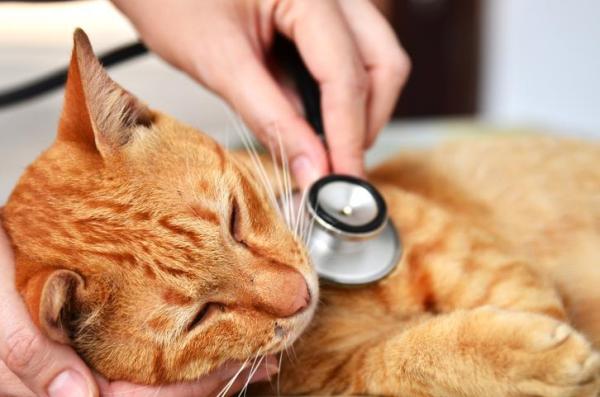How to Take an Aggressive Cat to the Vet - Practical Solutions



See files for Cats
Although there are extraordinarily docile cats, there are others who are nervous and even aggressive in the face of new situations, such as visiting the veterinarian. If, in addition, the cat has experienced such a trip before, and gone through relatively painful experiences in the process (such as getting their jabs), the cat remembers them, so their nervousness can increase. All this sometimes makes the visit to the vet become an unpleasant experience for the cat, their owner and the specialists themselves.
On AnimalWised we love cats and want their well-being, so we would like to give some advice on how to take an aggressive to the vet with some simple tricks.
Plan the check-up
If your cat is aggressive and does not like going the veterinarian, it is important not to make them stay in the vet longer than necessary, for everybody's sake. By this we do not mean that your visit to the vet should be carried out sparcely or incompletely, that a consultation and physical examination should be carried out sparse and incomplete, since, as we will see later, the time for check-up and exploration of your pet should never be spared and all necessary tests must be carried out, no matter how long they take. We are referring to not having to wait for too long in the vet's waiting room, as your cat will have to be confined in their carrier during the whole time, in an unknown place where there are or have been other cats or even dogs, so the cat will be getting more and more nervous and aggressive.
To avoid this as much as possible, it is advisable to call the veterinarian prior to requesting an appointment, informing him/her of your pet's character to try to make an appointment at a time when the clinic is not too busy to avoid possible delays.
Realte the carrier to positive stimuli
Cats are extraordinarily intelligent animals and they know when we are plotting something, they also have a better memory than we think. For this reason, and especially if you have had totake the cat to the veterinarian often, the animal detects the actions we usually do before taking them to the clinic, such as picking up their health card and obviously putting your cat in the carrier, an action that not only makes your cat become aggressive in the veterinarian, but they may also begin to show that attitude even before leaving home. Therefore, it is advised to avoid the cat seeing us perform such preparations.
Regarding how to put your cat in the carrier, which is absolutely unavoidable, it is convenient to get your pet used to being in the carrier. This can be achieved by putting the cat in it on some other occasion when they will not leave the house, without anything bad happening, and give them food and prizes while they are in it. The aim is to make the feline associate the carrier with positive stimuli.
If it is a classic carrier, from which you can remove the top and the door leaving only the bottom, which will look similar to a tray, it may be easier to start by placing them on the tray and, when they accept being in it, repeat this action with the carrier closed. This will helpyour cat get used to it as much as possible and he or she will see it as something so negative.
Adding a blanket or toy your cat recognizes in the carrier to take it with you to the veterinarian can be quite useful.

Relax your cat before you take them to the vet
There are physical or pharmacological ways to partially reduce the anxiety and aggressiveness of the cat before going to the veterinarian. Thus, placing pegs on the back of the cat's neck, which is where their mother grabbed them when they were puppies, can help reassure them enough. They sell special pegs designed for this purpose in many veterinary centers and specialized stores, although some stationery ones can be used, but paying attention so that the pressure is not excessive or the pegs injure the animal's skin. If you have never done this before and you have doubts, before you harm your cat, consult with the vet so he can show you how to do it correctly.
Calming drugs that help reduce cat anxiety are also available. These medicines must be prescribed by the veterinarian after presenting the case, since they can only be legally acquired with veterinary prescription and, although if they are used correctly they are very safe, a bad dosage of the same can have fatal consequences. Moreover, as these drugs make your cat sleepy, he or she may feel more vulnerable and act even more aggressively.
On the other hand, diverting the attention of the aggressive animal with their favorite toys or food can also be good options, even during the time they are in their carrier as we said in the previous section to keep them calm during their journey.
During the vet check-up
You should remember that, since most cats live at home and do not interact with other animals, they don't get ill as often as dogs do, so they usually go to the vet less frequently than dogs, in many cases only once a year for vaccines. Therefore, since they are not used to the veterinarian touching them, it becomes necessary for their check up to be as thorough as possible when you get a chance to visit them. In this way, when it comes to cats that get very aggressive in the veterinarian and there is nothing you can do to calm them, it is necessary to resort to sedation to be able to explore them properly and not to overlook anything.
Sedation should always be performed by the veterinarian and sometimes it is possible to do so without removing the cat from the carrier, taking advantage of the box slots to introduce the syringe.

The importance of education
To concludethis article, we'd like to say that, in general, taking care of the education of your feline to make them docile is beneficial not only to prevent the cat from becoming aggressive in the veterinarian, but for several reasons. A well-educated cat manages to communicate better with their human companion, a fact that strengthens the bond between both, helps to achieve a good coexistence and to keep the animal balanced and happy.
Unfortunately, however, it is not an exact science, and proper education is not always a guarantee of pleasant veterinary visits. On the one hand, each cat has a certain temperament that is sometimes difficult to change no matter how hard we try; on the other hand, sometimes aggressive cats may be extremely submissive in the veterinarian and quiet and well-behaved cats exhibit unexpected signs of aggressiveness when encountered in a strange environment, being kind of unpredictable. Therefore, it is important to ensure the correct education of the animal, but also to have the appropriate knowledge to know how to act if the feline finally shows signs of aggressiveness.
If you want to read similar articles to How to Take an Aggressive Cat to the Vet - Practical Solutions, we recommend you visit our Behavioral problems category.







